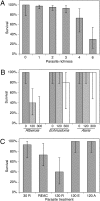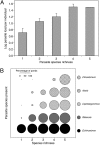Parasite diversity and coinfection determine pathogen infection success and host fitness
- PMID: 22615371
- PMCID: PMC3384156
- DOI: 10.1073/pnas.1201790109
Parasite diversity and coinfection determine pathogen infection success and host fitness
Abstract
While the importance of changes in host biodiversity for disease risk continues to gain empirical support, the influence of natural variation in parasite diversity on epidemiological outcomes remains largely overlooked. Here, we combined field infection data from 2,191 amphibian hosts representing 158 parasite assemblages with mechanistic experiments to evaluate the influence of parasite richness on both parasite transmission and host fitness. Using a guild of larval trematode parasites (six species) and an amphibian host, our experiments contrasted the effects of parasite richness vs. composition, observed vs. randomized assemblages, and additive vs. replacement designs. Consistent with the dilution effect hypothesis extended to intrahost diversity, increases in parasite richness reduced overall infection success, including infections by the most virulent parasite. However, the effects of parasite richness on host growth and survival were context dependent; pathology increased when parasites were administered additively, even when the presence of the most pathogenic species was held constant, but decreased when added species replaced or reduced virulent species, emphasizing the importance of community composition and assembly. These results were similar or stronger when community structures were weighted by their observed frequencies in nature. The field data also revealed the highly nested structure of parasite assemblages, with virulent species generally occupying basal positions, suggesting that increases in parasite richness and antagonism in nature will decrease virulent infections. Our findings emphasize the importance of parasite biodiversity and coinfection in affecting epidemiological responses and highlight the value of integrating research on biodiversity and community ecology for understanding infectious diseases.
Conflict of interest statement
The authors declare no conflict of interest.
Figures



References
-
- Cardinale BJ, et al. Effects of biodiversity on the functioning of trophic groups and ecosystems. Nature. 2006;443:989–992. - PubMed
-
- Tilman D, et al. Biodiversity and ecosystem properties. Science. 1997;278:1866–1867.
-
- Hooper DU, et al. Effects of biodiversity on ecosystem functioning: A consensus of current knowledge. Ecol Monogr. 2005;75:3–35.
-
- Fukami T, et al. Assembly history dictates ecosystem functioning: evidence from wood decomposer communities. Ecol Lett. 2010;13:675–684. - PubMed
-
- Hooper DU, Vitousek PM. The effects of plant composition and diversity on ecosystem processes. Science. 1997;277:1302–1305.
Publication types
MeSH terms
LinkOut - more resources
Full Text Sources
Other Literature Sources

